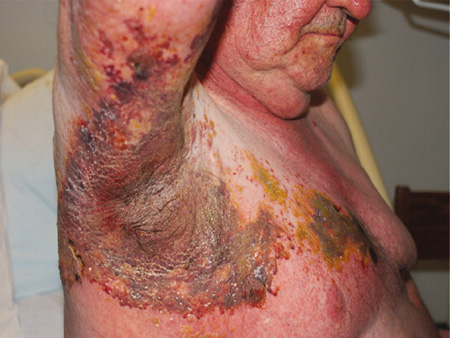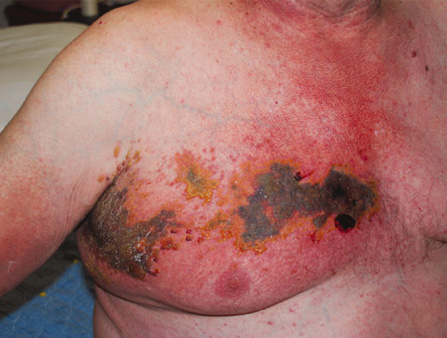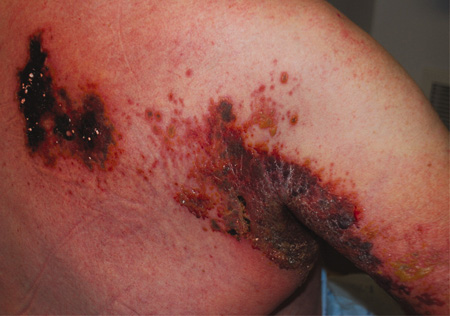Approach
Diagnosis is usually clinical, not requiring tests or culture.
Signs and symptoms
A typical presentation shows dermatomal pain followed by a rash in the affected area. Approximately 70% to 80% of patients with HZ present with pain in the dermatome where skin lesions subsequently appear.[22] The pain usually lasts 2 to 3 days before the development of a rash in the affected dermatome. However, some patients have presented with pain for approximately 1 week before development of a rash.[3] This pain can be constant or intermittent and is typically described as burning, stabbing, or throbbing. The severity varies, and pain can be so severe as to interfere with sleep and quality of life.[71] The rash initially is erythematous with a macular base and is followed rapidly by the appearance of vesicles within 1 to 2 days, continuing for 3 to 4 days. The lesions tend to be clustered along the branches of the cutaneous sensory nerve. Pustulation of vesicles begins within 1 week of the onset of rash, followed 3 to 5 days later by lesion ulceration and crusting.[Figure caption and citation for the preceding image starts]: Severe herpes zoster in an immunocompromised patient involving dermatomes T1 and T2BMJ Case Reports 2009 [doi:10.1136/bcr.07.2008.0533] Copyright © 2009 by the BMJ Publishing Group Ltd. [Citation ends]. [Figure caption and citation for the preceding image starts]: Severe herpes zoster in an immunocompromised patient involving dermatomes T1 and T2BMJ Case Reports 2009 [doi:10.1136/bcr.07.2008.0533] Copyright © 2009 by the BMJ Publishing Group Ltd. [Citation ends].
[Figure caption and citation for the preceding image starts]: Severe herpes zoster in an immunocompromised patient involving dermatomes T1 and T2BMJ Case Reports 2009 [doi:10.1136/bcr.07.2008.0533] Copyright © 2009 by the BMJ Publishing Group Ltd. [Citation ends]. [Figure caption and citation for the preceding image starts]: Severe herpes zoster in an immunocompromised patient showing multiple groupled vesicles, a few pustules, and extensive blackish adherent crusts with underlying erosions notedBMJ Case Reports 2009 [doi:10.1136/bcr.07.2008.0533] Copyright © 2009 by the BMJ Publishing Group Ltd. [Citation ends].
[Figure caption and citation for the preceding image starts]: Severe herpes zoster in an immunocompromised patient showing multiple groupled vesicles, a few pustules, and extensive blackish adherent crusts with underlying erosions notedBMJ Case Reports 2009 [doi:10.1136/bcr.07.2008.0533] Copyright © 2009 by the BMJ Publishing Group Ltd. [Citation ends]. Approximately 20% of patients present with systemic symptoms such as fever, headache, malaise, or fatigue.[3] Rarely, pain without rash (zoster sine herpete) can occur.[72]
Approximately 20% of patients present with systemic symptoms such as fever, headache, malaise, or fatigue.[3] Rarely, pain without rash (zoster sine herpete) can occur.[72]
Laboratory evaluation
Polymerase chain reaction (PCR) is the most sensitive and specific test for identifying varicella-zoster virus (VZV) DNA, but is expensive. Immunohistochemical analysis of a skin scraping is less expensive and still has a sensitivity of 90% and specificity of 95%. Culture of the virus is very specific but has a very low sensitivity as a result of virus lability or fragility.[3][22] In almost all cases, HZ can and should be diagnosed by history and physical examination. Confirming the diagnosis via laboratory testing may be necessary to differentiate genital zoster from herpes simplex, or to diagnose HZ pain without skin lesions (zoster sine herpete).
Because HZ is an HIV indicator condition (i.e., the prevalence of undiagnosed HIV in HZ is more than 0.1%), it is strongly recommended that patients with HZ should be offered an HIV test.[73][74]
Use of this content is subject to our disclaimer